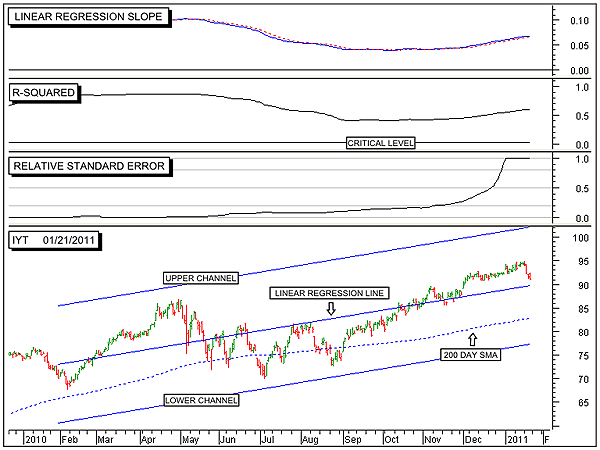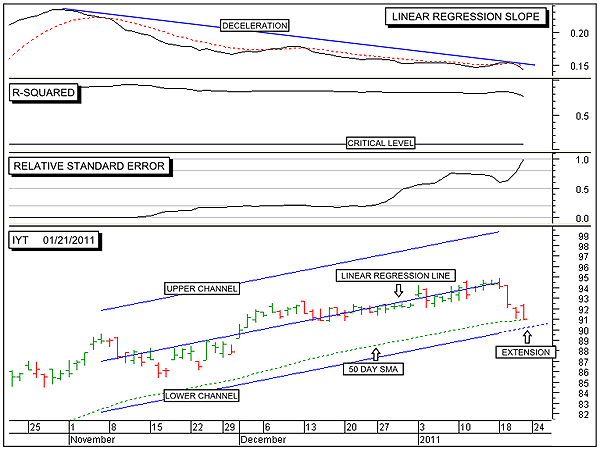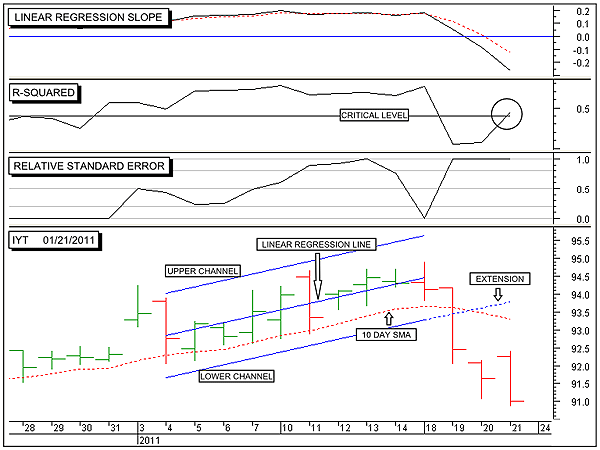
HOT TOPICS LIST
- MACD
- Fibonacci
- RSI
- Gann
- ADXR
- Stochastics
- Volume
- Triangles
- Futures
- Cycles
- Volatility
- ZIGZAG
- MESA
- Retracement
- Aroon
INDICATORS LIST
LIST OF TOPICS
PRINT THIS ARTICLE
by Alan R. Northam
Statistical analysis is used to show the long-term, intermediate-term, and short-term trends of the transportation market sector.
Position: N/A
Alan R. Northam
Alan Northam lives in the Dallas, Texas area and as an electronic engineer gave him an analytical mind from which he has developed a thorough knowledge of stock market technical analysis. His abilities to analyze the future direction of the stock market has allowed him to successfully trade of his own portfolio over the last 30 years. Mr. Northam is now retired and trading the stock market full time. You can reach him at inquiry@tradersclassroom.com or by visiting his website at http://www.tradersclassroom.com. You can also follow him on Twitter @TradersClassrm.
PRINT THIS ARTICLE
LIN. REGTREND
A Statistical Look At Transportation
01/25/11 10:01:16 AMby Alan R. Northam
Statistical analysis is used to show the long-term, intermediate-term, and short-term trends of the transportation market sector.
Position: N/A
| Figure 1 shows the long-term picture of the iShares Dow Jones Transportation exchange traded fund (ETF)(IYT). The bottom window of Figure 1 shows the daily trading bars along with the 200-day linear regression line and its upper and lower channel lines. Note that the regression line shows that the long-term trend of the Dow Jones Transportation sector remains in a long-term uptrend. |

|
| FIGURE 1: IYT, DAILY. This chart shows the daily price chart of Dow Jones Transportation ETF in the bottom window along with the 200-day linear regression channel, the linear regression slope indicator in the top window, the R-squared indicator in the second window, and the relative standard error indicator in the third. |
| Graphic provided by: MetaStock. |
| |
| The linear regression slope indicator in the top window is currently above its zero line and pointing in an upward direction. This indicates that price is continuing to accelerate in an upward direction. Note that price acceleration is an indicator of a strong trend. The R-squared indicator is shown in the second window from the top. This indicator is an indication of the strength of the trend. When the R-squared indicator is above its critical level, it is an indication that the trend is significantly strong and that there is a 95% probability that the trend will continue. The third window from the top shows the relative standard error indicator. This is an indicator that I developed to quantify the normal standard error indicator. When this indicator is above 0.8, it indicates high volatility. When it is between 0.8 and 0.5, it indicates above-average volatility. Below 0.5 and above 0.2, it indicates below-average volatility, and below 0.2, low volatility. Currently, volatility is extremely high. As long as the linear regression slope indicator and the R-squared indicator continue to move in an upward direction the long-term trend will remain in progress. However, the current presence of extremely high volatility warns of a major change in trend ahead. Note that this is a warning within the long-term trend and it will take several months before a major reversal in trend will have been completed. The next sign to look for would be for the R-squared indicator to move below its critical level, followed by the linear regression slope indicator moving below its zero level, signaling that the reversal in trend is at hand. Figure 2 shows the intermediate-term picture of IYT. The bottom window of Figure 2 also shows the daily price bars along with the 50-day linear regression line and its upper and lower channel lines. Note that the linear regression line shows that the trend remains upward over the intermediate-term time frame. |

|
| FIGURE 2: IYT, DAILY. This chart shows the daily price chart of Dow Jones Transportation ETF in the bottom window along with the 50-day linear regression channel, the linear regression slope indicator in the top window, the R-squared indicator in the second window, and the relative standard error indicator in the third. |
| Graphic provided by: MetaStock. |
| |
| The top window again shows the linear regression slope indicator over the intermediate-term time frame. Note that from November 2010, the linear regression slope indicator has been moving in a downward direction. This is an indication of price deceleration. Note that price deceleration normally occurs near the end of a trend and is thus a warning of an intermediate-term correction ahead or even a change in trend. The next lower window is that of the R-squared indicator. This indicator is a measure of the strength of a trend. This indicator remains well above its critical level, indicating an extremely strong significant trend. The third window down shows the relative standard error indicator over the intermediate-term trend. This indicator has now risen to 1.0, the highest level attainable, signaling an extremely high level of volatility. The importance of volatility is that when it is high, it indicates the possibility of a trend reversal ahead, and when it is low, it indicates the possibility that there is no trend reversal ahead. Thus, this indicator is warning of a reversal in trend ahead. Over the intermediate term price continues to decelerate and volatility is extremely high. These two indicators warn of a change in trend ahead. However, the R-squared indicator remains extremely strong. Normally, the R-squared indicator falls below its critical level before a reversal in trend occurs, so this is the indicator to watch. With the R-squared indicator remaining as strong in light of price deceleration and extremely high volatility, I would not be surprised to see one more attempt at a new higher high price before any reversal in trend occurs, but don't hold me to it. Figure 3 shows the short-term trend of the Dow Jones Transportation ETF. On the price chart, in the bottom window I have added the 10-day linear regression line along with its upper and lower channel lines. I have also shown where I have extended the lower channel line (see upward sloping dotted blue line). Note that price has now broken down below this lower channel line extension, signaling the end of the short-term uptrend. |

|
| FIGURE 3: IYT, DAILY. This chart shows the daily price chart of Dow Jones Transportation ETF in the bottom window along with the 10-day linear regression channel, the linear regression slope indicator in the top window, the R-squared indicator in the second window, and the relative standard error indicator in the third. |
| Graphic provided by: MetaStock. |
| |
| In the top window I have shown the linear regression slope indicator. Note that this indicator has now fallen below its zero line, indicating a reversal in trend from up to down. In addition, note that this indicator is below its three-day simple moving average, indicating that price is now accelerating in the downward direction. Recall that price acceleration is an indication of strength. The next lower window shows the R-squared indicator. Note that this indicator has just moved above its critical level, indicating that there is now a significantly strong trend in progress and that there is a 95% probability that this downward trend will remain in progress. Keep in mind, however, that the nature of short-term trends is that they are short term. The third window down from the top shows the relative standard error indicator. This indicator shows that volatility remains extremely high. Here is a tip about volatility: Volatility normally increases just before a reversal in trend, and once the reversal occurs, volatility often remains at high levels. Once a trend reversal occurs, we must give volatility time to settle down. If volatility doesn't settle down within a reasonable time frame, it could be an indication that the new trend is not going to last very long. The short-term trend has now reversed from up to down. |
| In conclusion, the statistical analysis of the iShares Dow Jones Transportation ETF shows that over the long term, the transportation sector remains in an uptrend. However, this analysis also shows that the intermediate-term trend could be nearing a reversal. Over the short term, the trend has already reversed downward. Looking in the bottom window of Figure 2, note that price is now close to the lower linear regression channel line. With the short-term trend just now establishing itself in a downtrend, this could be an indication that price will break down below this intermediate-term lower linear regression channel line. If this occurs, it will signal the end of the uptrend over the intermediate term and could then drive price down to the 200-day simple moving average or lower, as shown in Figure 1 (see the last intermediate-term correction during April through June for reference). |
Alan Northam lives in the Dallas, Texas area and as an electronic engineer gave him an analytical mind from which he has developed a thorough knowledge of stock market technical analysis. His abilities to analyze the future direction of the stock market has allowed him to successfully trade of his own portfolio over the last 30 years. Mr. Northam is now retired and trading the stock market full time. You can reach him at inquiry@tradersclassroom.com or by visiting his website at http://www.tradersclassroom.com. You can also follow him on Twitter @TradersClassrm.
| Garland, Tx | |
| Website: | www.tradersclassroom.com |
| E-mail address: | inquiry@tradersclassroom.com |
Click here for more information about our publications!
PRINT THIS ARTICLE

|

Request Information From Our Sponsors
- StockCharts.com, Inc.
- Candle Patterns
- Candlestick Charting Explained
- Intermarket Technical Analysis
- John Murphy on Chart Analysis
- John Murphy's Chart Pattern Recognition
- John Murphy's Market Message
- MurphyExplainsMarketAnalysis-Intermarket Analysis
- MurphyExplainsMarketAnalysis-Visual Analysis
- StockCharts.com
- Technical Analysis of the Financial Markets
- The Visual Investor
- VectorVest, Inc.
- Executive Premier Workshop
- One-Day Options Course
- OptionsPro
- Retirement Income Workshop
- Sure-Fire Trading Systems (VectorVest, Inc.)
- Trading as a Business Workshop
- VectorVest 7 EOD
- VectorVest 7 RealTime/IntraDay
- VectorVest AutoTester
- VectorVest Educational Services
- VectorVest OnLine
- VectorVest Options Analyzer
- VectorVest ProGraphics v6.0
- VectorVest ProTrader 7
- VectorVest RealTime Derby Tool
- VectorVest Simulator
- VectorVest Variator
- VectorVest Watchdog
